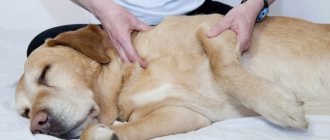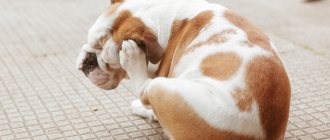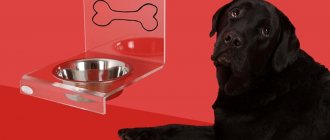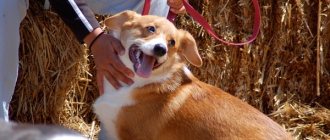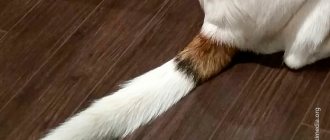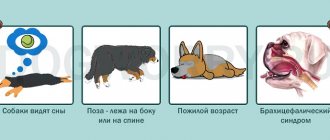What is lameness
When an animal's gait changes due to a step disorder, they speak of lameness.
In this case, the dog does not step completely on the problematic limb, trying to redistribute the body weight onto healthy paws. At rest, the animal tucks its affected leg.
The front paws are most often damaged because they bear the brunt of the load when jumping and running.
How does lameness manifest?
Even without signs of visible damage, you can understand that your pet has problems with its limbs.
The following symptoms will help identify lameness:
the inability of the animal to lean on the sore leg;- pain when walking and at rest;
- inability to stand on the problematic limb from a lying position;
- specific cracking in the joints.
If the pain is severe, the pet will whine and lick its paw. When leaning on a sore limb, the dog stretches its neck forward and throws back its head.
In addition to general signs, there are also other symptoms that characterize the type of disease and the degree of complication.
Types of lameness
Depending on the factor that provoked the problem, lameness can be different and manifest itself in different ways.
Types of lameness in animals
| Lameness | Description |
| leaning limb | Soreness occurs when the animal tries to stand on the problematic paw. At the same time, it shows restlessness, refuses to move, whines, and sometimes trembles. Pathology occurs when ligaments, tendons, bones are damaged, pads or claws are injured. |
| hanging limb | Painful symptoms appear when the dog tries to move its paw. Muscle injury is to blame here. |
| mixed type | There are signs of the two previous types. The problem is provoked by inflammatory processes affecting large joints (knees, hips, etc.) |
Painful symptoms can be different in nature, depending on the severity of the damage to the limb.
Functional disorders in animals are divided into 3 degrees:
The first includes mild lameness, in which the dog is able to briefly place emphasis on the problematic limb, but tries to step on the paw as little as possible to avoid pain.- Second degree: the pet tries to avoid stepping on the affected limb and carries it forward or presses it forward.
- the third degree is characterized by spasmodic movement of the dog due to the fact that it is generally unable to lean on the affected paw or even move it.
Lameness in dogs is classified according to other parameters depending on the causes of the disease.
Congenital leg defects
There is such a thing as intermittent claudication (also called Patella's disease). She appears suddenly and quickly disappears. It affects dwarf breeds, for which luxation of the kneecap is a common occurrence.
This does not cause any particular problems for the dog, but if repeated frequently, such lameness can lead to degenerative changes.
Another pathology that is inherited is Perthes disease. It is more typical for dwarfs, but the genetic disease can also appear in puppies of other breeds.
Lameness is provoked by deformation of joint and bone tissues that occurs against the background of suddenly developing necrosis.
All other types of lameness are acquired. They can be triggered by mechanical injuries and chemical damage, organ diseases, infections, etc.
Types of disease
- Lameness of a leaning limb . It is characterized by pain when moving. The dog whines at this time, does not move forward at the owner’s command, and is constantly in a restless state. This form is typical for injury to the claws, damage to the pads on the paw, tendon-ligament, or bone apparatus.
- Lameness of the hanging limb - is expressed in painful sensations associated with the dog carrying the limb. This form is typical for injuries associated with impaired functionality of the muscular system.
- Mixed lameness - it includes elements of the two previous variations. It refers to acute inflammatory processes that occur in the area of large joints in a dog.
- Intermittent claudication is defined by an unexpected appearance and the same disappearance.
The latter type of disease is extremely typical for dogs of dwarf breeds. It is associated with a dislocated kneecap. Such lameness does not cause pain to the pet, nor does it cause any particular discomfort; however, in the future, the dog may develop a degenerative change in the joint area, which will become an unpleasant problem not only for the dog, but also for its owner.
In large dogs, lameness may occur due to hip dysplasia. This disease is purely hereditary and occurs as a result of a disorder in the development of the joint.
Causes of the condition
If a dog is limping on its front leg, first of all find out what is causing it. There are several most common reasons, and each of them can cause serious trouble for your pet.
Injuries of varying severity
It is the mechanical effect on tissue that most often causes lameness. A dog can also get injured during normal walking.
Even minor pad abrasions can cause pain and change your pet's stride. These include the following points:
cuts and puncture wounds;- splinters;
- joint bruises upon impact;
- sprains;
- dislocations;
- bone fractures.
Even snow packed between the toes can cause injury to an animal's paw. Mechanical damage also includes insect bites and poisonous reptiles.
Diseases
Dogs, like people, are susceptible to pathologies of joints, muscles, and bones. Among the main inflammatory diseases of the musculoskeletal system, it is worth highlighting arthritis and osteoarthrosis, which are the result of another serious lesion - dysplasia. The cartilage tissues of the joints of large and medium-sized pets suffer from this.
Not only older animals can get sick. Sometimes the musculoskeletal system is also affected in a young dog. The reason for this is old injuries, excessive exercise and poor nutrition.
Cyst between fingers
Short-haired dogs are more likely to suffer from this problem. The etiology of the disease has not been fully determined by scientists.
The root cause of the appearance of nodules is considered to be damage to the subcutaneous tissue, sebaceous glands, hair follicles caused by mechanical, chemical, thermal, parasitic, and infectious effects.
Chemical or thermal burns
Both high and low temperatures can impair the motor function of a pet.
In the first case, boiling water may accidentally fall on the dog, or the animal may jump onto a hot sheet of metal.
The second situation is possible in severe frosts, when there is a risk of frostbite on the paws.
Your pet will also get a burn if it comes into contact with aggressive liquids, such as stepping on spilled alkali, acid, fuel oil or gasoline.
In winter, animals often burn the pads of their limbs after walking on snow-covered roads, which are treated for ice with special reagents.
Treatment of lameness in dogs
Depending on the type of diagnosed pathology that causes the dog to limp, the veterinarian prescribes an individual treatment regimen, divided into a conservative and surgical part. If the dog is limping, self-treatment with human medications is prohibited. This is due to the fact that the cause of lameness is not eliminated, but the pain syndrome is suppressed. In the future, this can cause complications and death of the animal.
Conservative treatment involves changing the animal’s diet and exercise. To eliminate pain, the dog is prescribed a course of anti-inflammatory non-steroidal drugs, as well as drugs with chondroitin. It is also necessary to reduce the load on the musculoskeletal system during treatment. Surgery is performed to replace the damaged joint, as well as bone resection and resection arthroplasty.
Also learn about vitamins for dog joints.
Diagnostics: can it be done at home?
If the dog begins to behave with caution, it can be assumed that there are problems with its paws. The owner carefully examines the dog to look for signs of damage.
If they are not detected, but the animal reacts painfully to touch, it is recommended to test it in motion.
The pet's stride is assessed in several gaits. If there are no problems with the musculoskeletal system, then the movements will be smooth, springy, and free.
If there are barely noticeable signs of lameness, it is recommended to walk your pet along wet sand and carefully examine the paw prints. When a dog has pain in a limb, it carries it out with a twist inward.
If you measure the length of your step, it will be shorter than usual, and the footprint of the affected leg will be weaker than the others.
For further diagnosis, the pet is taken to a veterinary clinic for a hardware examination, where the dog is x-rayed in 2 projections (frontal and lateral). If the picture is unclear, a computed tomography scan is additionally prescribed.
Is it possible to ignore lameness in a dog?
The lameness may be minor (for example, the pet has slightly twisted its paw, but is running) and will go away on its own. Still, such symptoms cannot be ignored, because this may be a sign of an incipient serious disease of the bones and joints, including oncology.
Lameness is not always associated with limb problems. Sometimes it becomes a concomitant symptom of vertebral hernia, heart disease, gastrointestinal tract and other internal problems.
The dog has intermittent claudication.
Olga, Bat Yam
231 views
February 16, 2020
Hello! This is the situation. Fox Terrier dog, born in 2021, male. Eats dry food. Weight 9 kg, no heavy physical activity, no obvious injuries. About a month and a half ago he began to limp (left front paw). Lameness intermittent. We went to the doctor, he did an x-ray, but didn’t give a conclusion, he said that it looked like a tumor and told him to give the dog analgin. They didn’t give me analgin. We went to the veterinary hospital. There the dog was examined by a surgeon. I felt the entire paw from the shoulder down and did not find any problems, and the dog did not react at all. They could not make a diagnosis. The dog underwent a general blood test and a computed tomography scan of the shoulder joint. They said that the blood test was absolutely good, but they didn’t give it to me. That was the end of it. There is no diagnosis, the problem is not solved, the dog is limping. I am attaching X-rays and CT scans, as well as the CT scan report in English, because I don’t live in Russia. Translated into Russian by Google. I want to know if there are problems only in the shoulder or in other joints too? I would be very grateful if you can advise me something. Here is the CT report. Here is the CT report. Diagnosis: PROBLEM NOT IDENTIFIED Diagnoses 4573 PROBLEM NOT IDENTIFIED, Primary, Final, 05/02/2020, Hilli Raskansky Notes & Communication Other note — 05/02/2020 / Vered Shub CT report and pics CT left front limb pre and post contrast ( interpretation only): There is a 3.5mm x 2.5mm osseous body in the lateral aspect of the left humeroscapular joint in the middle of the ventral angle. This could be associated with the lateral glenohumeral ligament, joint capsule or within the joint. Accurate localization was challenging due to the rotated positioning of the dog. This finding can definitely explain the dog's lameness. The other bones and joints were unremarkable. ———————— Diagnoses 4573 PROBLEM NOT IDENTIFIED, Primary, Final, 05/05/2020, Hilly Raskansky Notes and communication Other note - 05/05/2020 / Vered Shub CT report and photo CT scan of left forelimb before and after contrast (interpretation only): In the lateral part of the left shoulder joint in the middle of the ventral angle there is a bone body measuring 3.5 x 2.5 mm. It may be associated with the lateral glenohumeral ligament, the joint capsule, or within the joint. Accurate localization required a special approach taking into account the dog's turning position. This could definitely explain the dog's lameness. Other bones and joints were unremarkable.
Age:
51
Chronic diseases:
no
The question is closed
dog
CT conclusion
dog analgina
How to treat
Even a slight bruise of the paw should not be ignored, hastening to provide all possible assistance to the pet. Treatment of lameness is carried out after clarifying the cause that caused it.
| Factor | Recommendations |
| Minor damage | Cuts or wounds on the paw pads are treated with hydrogen peroxide |
| Splinters | If there is deep damage to soft tissue, you will need medical alcohol. They moisten a cotton swab and apply it to the wound after the foreign object is removed from the paw. |
| Insect bites | At home, help is provided to the pet if the swelling is minor. The bite site is treated with a solution of soda (in a ratio of 1:10). When the dog is stung by a bee, the injured area is smeared with garlic juice. But if the animal has an allergic reaction to the bite, it is immediately sent to a veterinary clinic. An emergency visit to the doctor should also occur in case of a tarantula bite |
| Ticks | The problem occurs in the spring and summer. If the tick is not removed in time, the dog may die from encephalitis. To prevent this from happening, the pet is periodically examined to identify the attached insect. The detected pest must be removed, adhering to the following rules:
If you don’t have tweezers at hand, you can use a thick thread. But this requires skill |
| Dislocations and sprains | In this situation, the joint must be secured with a tight bandage and the pet taken to the doctor. Painful symptoms can be relieved by applying ice to the injured paw. |
| Fractures | You should not take the initiative here, because the slightest touch to the limb will cause severe pain in the dog. As a result, the animal can involuntarily injure its owner. All necessary assistance will be provided to the pet under anesthesia in the hospital. |
Minor lameness without damage quickly disappears if the dog is not stressed for a while. After the animal lies quietly for several days, it will be able to move actively again.
If there are no apparent reasons: owner actions
When, upon examining the pet, the owner is convinced that there are no visible injuries, he should not ignore the dog's lameness, even if the animal does not feel severe pain.
Such a problem does not arise because of trifles.
After observing the symptoms, the owner provides the pet with peace and, if necessary, provides all possible assistance. You should immediately call a veterinarian to your home so that he can assess the extent of the problem.
In situations where there is no time to wait for a specialist to arrive, the owner independently transports the dog to the hospital.
Lameness in dogs and cats
Treatment can be conservative or surgical. The choice of treatment method depends on many factors: the type of disease, treatment results, indications and contraindications for treatment, the capabilities (wishes) of the owner and veterinary specialist, as well as a number of others.
Conservative therapy
Conservative treatment includes diet therapy, body weight control, dosing or limitation of physical activity, physiotherapy, and the use of dietary supplements. A separate point is the use of medications.
Diet therapy.
Some pathologies in animals develop due to unbalanced feeding:
- Nutritional hyperparathyroidism with excess meat in the diet;
- Hypervitaminosis A in animals that feed primarily on liver;
- Lack of thiamine when eating low-quality feed;
- Lack of essential amino acids due to poor feeding.
To ensure complete feeding, the animal is transferred to a balanced diet. The easiest way is premium commercial feed.
Overweight animals
switch to a lower calorie diet.
In the acute phase of the disease, physical activity is reduced
- limited to short walks on a leash.
Subsequently, the load must be dosed
; it should not be insufficient or excessive.
To physiotherapy
are used after severe injuries and in the postoperative period in order to speed up the recovery process and improve the outcome of treatment.
Use of drugs
— A novice doctor prescribes twenty medicines for each disease;
An experienced doctor has one medicine for twenty diseases. — William Osler
Antimicrobials
.
If the cause of lameness is an infectious disease, the use of antibiotics, antimycotics or antiviral drugs is necessary. For example, for staphylococcal arthritis, doxycycline is prescribed based on the results of bacterial culture.
Anti-inflammatory drugs
.
For inflammatory diseases, the animal is prescribed medications that reduce the inflammatory process (NSAIDs, GCS). For example, age-related arthrosis of the joints is a degenerative-inflammatory disease in which non-steroidal anti-inflammatory drugs help well.
Immunomodulatory agents
.
A number of diseases are autoimmune in nature and are treated with drugs that affect the body’s immune response. Most often, glucocorticosteroids and immunosuppressants are used in orthopedics. For example, an animal with rheumatoid arthritis is prescribed methylprednisolone (“Metypred”).
Painkillers
. Painkillers are used as a temporary measure until the main treatment begins or if it is impossible to relieve the animal’s suffering in any other way. For the purpose of pain relief, veterinary medicine uses a huge number of drugs, which are selected individually in each case.
Advice to owners:
- There is no need to give animals painkillers or anti-inflammatory drugs on your own, especially “human” ones, even if they are “safe” by human standards. For example, if you give a cat a “human” Aspirin tablet, you will overdose the medicine 10 times, and one 100 mg Ketonal tablet is designed for a 100 kg dog!
- The use of medical “joint” ointments in dogs and cats is ineffective and dangerous. Animals do not tolerate these substances well and may ingest them.
Intra-articular injections
.
In some cases, administering medications to the affected area helps a lot. For example, animals with arthrosis benefit from the injection of hyaluronic acid (Chionate) or long-acting anti-inflammatory drugs (Kenalog) into the joint.
Prevention
If there are congenital pathologies, lameness is difficult to prevent. As for external factors, the owner is able to protect his four-legged friend from them.
It is enough to follow the basic rules:
choose suitable places for walking with minimal risk of bites and injuries;- do not overload the dog with physical activity during exercise, selecting exercises that are feasible for the animal;
- Carry out daily examinations of your pet to promptly identify injury or disease.
A balanced diet plays an important role in a dog’s health. The mineral components included in the feed strengthen bones and blood vessels and make muscle tissue elastic. This helps prevent the animal from developing problems with its limbs.
